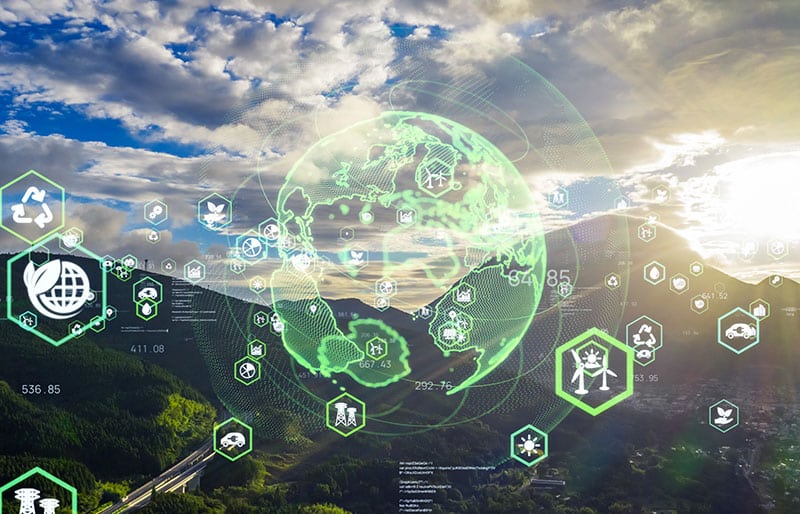The digital world faces a major challenge: reducing its impact on the environment.Artificial Intelligence(AI) is often presented as a miracle solution. But is this really the case?
This fascinating technology promises to revolutionize our relationship with the environment, like a modern-day superhero. It optimizes our data centers, makes our software smarter and even helps us create a more sustainable world.
But like all superpowers, AI needs energy to function. And here lies one of the most interesting challenges of our time: how can we transform this power into a true ally of our planet?
Between innovations and challenges, discover in this article how AI can be both a solution and a challenge for the environment.
AI and the environment: between promise and reality
Jacque Ellul, a well-known twentieth-century thinker on technology and alienation, quoted Camus as saying of technique (technology): “ Technique will have succeeded in replacing reflection by reflex “. This is the idea that technology leads us to think less about our needs (and what they imply), and to focus instead on how to meet them as quickly as possible.
This response often relies on technologies whose purposes and impacts completely elude users, and sometimes even the manufacturers themselves. This could be the case with AI.
Presented today as a potential solution to the digital transition to sustainability, AI in its current state is not really an example in this field. In this sense, could we believe that an arsonist could become a firefighter?
How AI optimizes the environmental impact of digital technology
AI, a pyromaniac with a fire extinguisher
Artificial intelligence is revolutionizing digital transformation and could undeniably be a powerful tool for meeting the challenges of a sustainable world. It is already helping to optimize resources, reduce waste and improve decision-making in key business sectors.
AI for data centers: the DeepMind example
Specifically in the digital sector, it can be called upon in a number of areas. Google, for example, uses DeepMind (called “Agent A.I” by the Group’s employees) to optimize its IT infrastructures, and in particular their cooling, reducing dedicated consumption by 40% over 10 years.
As a reminder, 70% of the energy consumed by a datacenter is used to cool it down. This shows us thatAI can act in a targeted way on existing tools, with precision and efficiency while adjusting in real time to the resource requirements of the various tools.
Green Software Foundation: when AI rethinks software
The concern is that the urgency of environmental issues is pushing us to go even further in terms of sustainability. Our tools today must be designed to be sustainable. Here too, AI could have a role to play. This is the vision of the members of the Green Software Foundation, founded by such digital pillars as Microsoft, GitHub and ThoughtWorks.
This initiative, in partnership with the Linux foundation, aims to reduce the software industry’s carbon footprint by integrating AI right from the design stage. Microsoft, for example, has integrated AI into its Azure Cloud to optimize task execution, thus reducing energy consumption due to storage.
Videoconferencing and AI: reducing the footprint of teleworking
Another application that couldn’t be more in tune with the times is videoconferencing.
As a reminder, according to an Apec study carried out in March 2024, a quarter of the French executive workforce has switched to telecommuting, with an average of 2 days per week. It’s also worth remembering that the impact is not negligible, and is mainly relative to the video stream, as demonstrated by the 2022 Greenspector study on the subject: on average, one minute of audio videoconferencing consumes 91% less data than with video activated.
As systematically deactivating cameras is not a feasible solution, not only in terms of our activities, but also in terms of the potential revival of a feeling of isolation among employees (see Les incidences du télétravail sur le travailleur dans les domaines professionnel, familial et social by Émilie Vayre), we need to think about how to reduce this impact.
Based on this idea, American manufacturer Nvidia has developed the Maxine platform. Here,AI is used to guarantee the quality of videoconferencing while reducing the bandwidth required, thereby reducing data consumption and the energy footprint associated with video communications. Here again,AI acts as an optimizer, able to adjust in real time to the needs of the tool’s user.
The environmental challenges of AI in 2025
Energy consumption: the true cost of AI
It should be noted that, for the moment, the scope of action is mainly limited to carbon emissions and energy consumption, leaving aside the issues of water (notably the question of water stress and the disruption of the water cycle) and the occupation of space by infrastructures, which could be the major issues of tomorrow.
Such initiatives nevertheless demonstrate the growing awareness on the part of major digital players of the need to reconcile the use ofAI with present and future environmental challenges. CSR has become a real lever for performance and innovation, and the aim would even be to integrate AI into sustainable development issues in the broadest sense.
The impact of infrastructure on the environment
In early 2025, France co-chaired the Artificial Intelligence(AI) Summit with India. The French government announced an ambitious plan: 35 “ready-to-use” sites have been chosen in France to host data centers, essential to the development of these tools. In the days leading up to the summit, environmental lawyer Thomas Le Goff declared: ” Laissez-faire could compromise the development of AI, and lead to a world incompatible with climate objectives “.
Towards responsible use of AI
Turning arsonist into firefighter
Optimizing the use of AI in business
It’s clear thatArtificial Intelligence could be a considerable asset in transforming both our businesses and our societies.
It could provide a response to climate change and the environmental crisis that concerns us all. But we must act quickly to ensure that it does not become a gas pedal.
By 2027, a Cornell University study predicts that AI will consume between 4.2 and 6.6 billion cubic meters of water, slightly more than the annual consumption of Denmark. And that’s only a low range, given the global ambitions for its development.
As for energy consumption, a recent study by Epoch AI has reassured the world that the energy cost of a GPT query is 0.3 Watt hours, 10 times lower than initial estimates. This can be explained by technological advances and system optimization, including new chips (NVIDIA H100) with energy savings of over 60%.
However, we don’t use GPT as a simple search engine. This AI is designed for structured interactions with more or less complex responses that can be sustained over time, leading to more exchanges for a search than a simple request on Google.
Best practices for sustainable AI
As well as working to make AI sustainable in its design, we need to learn how to optimize its use. Contrary to conventional wisdom on CSR, it’s usage that often defines the purpose of a technology.
Training employees in environmental issues
With this in mind, and assuming that the use of AI becomes widespread, we need to learn how to use it correctly, so that we can use it in a reasoned and responsible way.
In companies, raising employee awareness of effective prompts can be considered, reducing the number of requests and increasing the accuracy of the response. This is also the case for the GDPR, which sees the emergence of new risks with AI.
In addition to general AIs like GPT, there are many others, each specializing in certain types of response. Email assistants, automatic note-takers in meetings, presentation facilitators – these are just some of the tools that may or may not actually be useful. It is becoming necessary to take into account the utility-impact ratio in the widespread use of this type of AI in our internal systems, and to raise employee awareness on the subject.
Conclusion: the future of environmental AI
No smoke without fire
There’s no precise answer to the question of AI as a lever for digital sustainability. But it does lead to another reflection, echoing Pierre Rabhi’s view that “ the environmental crisis is above all a civilizational crisis “.
So should we really be wary of tools or their use? We need to judge the tool in the light of its potential uses, particularly in relation to human nature and the trends that influence it. So the question is not whether artificial intelligence can be the solution to the environmental crisis. Rather, the question is whether we now have the maturity to make it a solution, if not a major problem. We need to take these questions into account if we are to avoid reproducing Javon’s eternal paradox, in which many of our “innova-solutions” are trapped.
What’s certain is that its use must be based on an education of each and every one of us, to ensure that the reflex is the armed arm of reflection and not its replacement.
Do you want to optimize the environmental impact of your digital tools? For over 30 years, SQORUS has been supporting companies in their digital transformation.
Our digital responsibility experts assess your current digital footprint and work with you to build a tailor-made strategy. From initial audit to change management, we’re at your side to help you make the transition to a more sustainable digital environment.
35 HR innovations and trends for 2024
Discover the latest HR innovations and trends and accelerate your digital transformation.
Contact
A project? A request?A question?
Contact us today and find out how we can work together to make your company’s digital future a reality.













